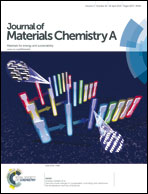Ru0.01Ti0.99Nb2O7 as an intercalation-type anode material with a large capacity and high rate performance for lithium-ion batteries†
Abstract
RuxTi1−xNb2O7 (x = 0 and 0.01) materials have been synthesized via a solid-state reaction method. X-ray diffraction combined with Rietveld refinements demonstrates that both samples have a Wadsley–Roth shear structure with a C2/m space group without any impurities, and that the unit cell volume increases after the trace Ru4+ doping. Scanning electron microscopy and specific surface area tests reveal that the Ru4+ doping decreases the average particle size. The Li+ ion diffusion coefficient and electronic conductivity of Ru0.01Ti0.99Nb2O7 are respectively 64% and at least two orders of magnitude larger than those of the pristine TiNb2O7. First-principles calculations show that the increased electronic conductivity can result from the formation of impurity bands after the Ru4+ doping. Ru0.01Ti0.99Nb2O7 exhibits a large initial discharge capacity of 351 mA h g−1 at 0.1 C between 3.0 and 0.8 V vs. Li/Li+, approaching its theoretical capacity (388 mA h g−1). At 5 C, unlike the pristine TiNb2O7 with a small charge capacity of 115 mA h g−1, Ru0.01Ti0.99Nb2O7 delivers a large value of 181 mA h g−1, even exceeding the theoretical capacity of the popular spinel Li4Ti5O12 (175 mA h g−1). After 100 cycles, Ru0.01Ti0.99Nb2O7 shows a large capacity retention of 90.1%. These outstanding electrochemical performances can be attributed to its improved Li+ ionic and electronic conductivity as well as smaller particle size.



 Please wait while we load your content...
Please wait while we load your content...